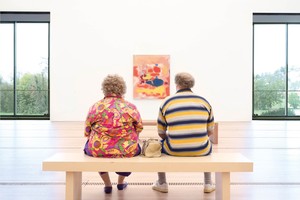
Duane Hanson: To Shock Ourselves
On the occasion of an exhibition at Fondation Beyeler, novelist Rachel Cusk considers the ethical and aesthetic arrangements that Duane Hanson’s sculpture initiates within the viewer.
January 3, 2023
To celebrate their twenty-fifth anniversary, Fondation Beyeler, Riehen/Basel, Switzerland, staged an exhibition entitled Jubiläumsausstellung—Special Guest Duane Hanson. The presentation featured several sculptures by Duane Hanson alongside more than one hundred works from the foundation’s collection. Alice Godwin considers the fertile dialogues produced by these juxtapositions.
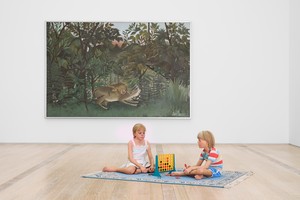
Installation view, Jubiläumsausstellung—Special Guest Duane Hanson, Fondation Beyeler, Riehen/Basel, Switzerland, October 30, 2022–January 8, 2023. Artwork, front to back: © 2023 Estate of Duane Hanson/Licensed by VAGA at Artists Rights Society (ARS), New York; Henri Rousseau. Photo: Lucia Hunziker/LL Productions
Installation view, Jubiläumsausstellung—Special Guest Duane Hanson, Fondation Beyeler, Riehen/Basel, Switzerland, October 30, 2022–January 8, 2023. Artwork, front to back: © 2023 Estate of Duane Hanson/Licensed by VAGA at Artists Rights Society (ARS), New York; Henri Rousseau. Photo: Lucia Hunziker/LL Productions
Duane Hanson’s hyperrealistic figures, scattered among the masterpieces of the Fondation Beyeler in Riehen/Basel, could easily be mistaken for visitors who have just wandered off the tourist bus or workers hired to clean the windows and paint the walls. There is a distance between these people and the Beyeler’s collection. Their juxtaposition is charged with satire, as in the case of the man in a sweat-stained T-shirt riding a lawn mower beside Claude Monet’s Nymphéas (1916–19). Is art more valuable than the lives of these ordinary Americans? Can these people, with real-life struggles, truly care about art?
Hanson’s “types” of middle-class and working Americans provide a new context for the Beyeler’s collection, including the Pop art of Andy Warhol. Though Hanson rejected Pop, he was fascinated by its “banal vulgarity,”1 and noted the influence of mass media in his own subjects: “Why not look at this guy sitting right next to me, what’s going on, what I see on the TV and in the newspaper.”2 Hanson and Warhol even planned to make portraits of one another, which the latter embarked upon before his death. “Don’t push so hard because that distorts,” Hanson recalls Warhol saying, as he posed with a hand against his cheek.3
Warhol echoes Hanson’s gesture in his own silkscreened Self-Portrait (1967), which faces a Hanson sculpture of two people at a table: an average couple in a diner, perhaps, with a melting ice-cream sundae and an empty Coke bottle between them. On closer inspection, we realize the male figure is the artist himself. Hanson’s and Warhol’s eyes are both fixed on the middle-aged woman in her gingham dress. There is something pitying in their gaze; they understand she will never be like the aspirational figures in the magazine she’s reading. We are confronted instead by the desperate reality for those failed by the American dream.
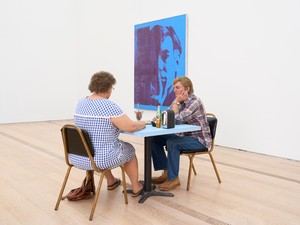
Installation view, Jubiläumsausstellung—Special Guest Duane Hanson, Fondation Beyeler, Riehen/Basel, Switzerland, October 30, 2022–January 8, 2023. Duane Hanson artwork © The Estate of Duane Hanson/2022, ProLitteris, Zurich. Andy Warhol artwork © 2023 The Andy Warhol Foundation for the Visual Arts, Inc./Artists Rights Society (ARS), New York. Photo: Lucia Hunziker/LLH Productions
Hanson and Warhol emerged in the wake of Abstract Expressionism in America, and Hanson recalls his early experiments with abstraction: “I would try to do abstract work, but I always put a bit of an arm or nose in it. I never could just do nonfigurative work.”4 At the Beyeler, Hanson’s Old Couple on a Bench (1994) is immersed in the shimmering color fields of a Mark Rothko. Amid hues of crimson and rose, midnight-blue and gray, plum and brown, the pair sit in silence, lost for words. Are they killing time before their bus leaves? Or are they simply overwhelmed by emotion?
In many ways, the haunting stillness of Hanson’s figures and the intensity of their realism speaks to the raw emotion of Rothko’s paintings. Just as Rothko could bring viewers to tears with the invocation of “basic human emotions” like “tragedy, ecstasy, [and] doom,”5 Hanson’s sculptures confront the sensations of loneliness and frustration within ordinary people.
Hanson’s focus upon human experience draws a parallel with the brutal expression of humanity by Alberto Giacometti. Art historian Marco Livingstone explains: “Like Alberto Giacometti in his attenuated reformations of the human body in bronze . . . Hanson sought above all to convey through his art an immediate and uncanny evocation of human beings.”6 Throughout his career, Giacometti tussled with what it meant to be human, reaching a crescendo with the gaunt, standing figures that embodied the existential trauma of the postwar era. Livingstone argues that Hanson went beyond a “form of realism that could be felt in the bones and irradiated through the nervous system” and followed “that initial visceral shock of recognition with a second jolt of astonishing surface resemblance.”7
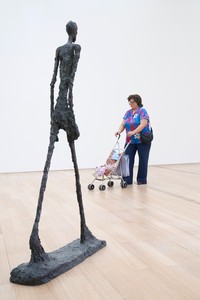
Installation view, Jubiläumsausstellung—Special Guest Duane Hanson, Fondation Beyeler, Riehen/Basel, Switzerland, October 30, 2022–January 8, 2023. Duane Hanson artwork © The Estate of Duane Hanson/2022, ProLitteris, Zurich. Alberto Giacommetti artwork © 2023 Alberto Giacometti Estate/Licensed by VAGA and Artists Rights Society (ARS), New York. Photo: Lucia Hunziker/LLH Productions
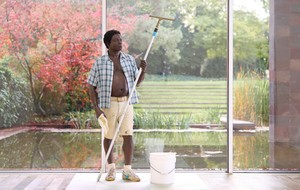
Installation view, Jubiläumsausstellung—Special Guest Duane Hanson, Fondation Beyeler, Riehen/Basel, Switzerland, October 30, 2022–January 8, 2023. Duane Hanson artwork © The Estate of Duane Hanson/2022, ProLitteris, Zurich. Photo: Lucia Hunziker/LLH Productions
At the Beyeler, Hanson’s Woman with Child in a Stroller (1985) is placed alongside Giacometti’s L’Homme qui marche II and totemic Grande femme III and IV (all 1960). The mother’s erect body echoes those of the women that surround her, while the diagonal of her extended arms holding the stroller forms a triangle that mirrors the pose of Giacometti’s walking man, tilted forward and striding through space. Stillness and dynamism are bound together in Hanson’s figure, who appears as if she might push the stroller at any time, resonating with Giacometti’s description of movement as “a succession of moments of stillness.”8
Hanson eliminated motion from his sculptures as the phantasm of realism grew more important. In its place, he harnessed stillness and contemplative moods to convey the enduring experience of humanity, giving “permanent form to transient flesh.”9 This notion reverberates with the portraits of Paul Cezanne and John Elderfield’s description of their “settled permanence of character.”10 In his magnificent Madame Cézanne à la chaise jaune (1888–90) at the Beyeler, Cezanne’s wife, Marie-Hortense, sits stoically with her hands in her lap. She is dressed in a vibrant red dress against a yellow patterned chair. Her pose and flamboyant clothing mirror Hanson’s Old Lady in Folding Chair (1976) nearby. Is this a vision of Madame Cezanne’s future?

Installation view, Jubiläumsausstellung—Special Guest Duane Hanson, Fondation Beyeler, Riehen/Basel, Switzerland, October 30, 2022–January 8, 2023. Duane Hanson artwork © The Estate of Duane Hanson/2022, ProLitteris, Zurich. Photo: Lucia Hunziker/LLH Productions
Both women have been maligned: Marie-Hortense as Cezanne’s long-suffering mistress, whom he lived with intermittently and eventually married after the death of his disapproving father; and the elderly woman who has been ignored by society. Hanson purposefully addressed such forgotten groups and bestowed them with dignity. The old woman is rendered with tender honesty and respect here, capturing her wrinkles and legs dappled with bruises and veins, as well as her lightly made-up face, clipped hair, and white shoes and bag, which match the cardigan carefully buttoned at her neck.
The women share a sense of indifference to their surroundings. They stare into the middle distance and are consumed by their thoughts. Marie-Hortense’s features are distilled into Cezanne’s essential formal language of “the cylinder, the sphere, and the cone.”11 As the French Symbolist Paul Sérusier notes in his discussion of Cezanne: “The subject disappeared; there is only a motif.”12 Arguably, this approach to the figure as a “motif,” treating the body with the same formal intensity as a still life, resonates with Hanson’s construction of “types.” Cezanne once chastised the art dealer Ambroise Vollard for falling asleep during a sitting: “Do I have to tell you again you must sit like an apple?”13
Hanson’s sculptures in the galleries of the Fondation Beyeler are like our doppelgängers, reframing our appreciation of the collection through their discerning eyes and the context of middle America. As Livingstone writes, Hanson hits us with the “maximum dose of reality so that the intensity of its presence could radiate outwards.”14 This “dose of reality” makes us rethink the way in which we view art, as we find ourselves being observed in return.
1 Christine Giles, “‘Do You Know the Time?’: A Biography,” in Duane Hanson: A Virtual Reality (Palm Springs, California: Palm Springs Desert Museum, 2000), p. 47.
2 Duane Hanson quoted in Giles, “‘Do You Know the Time?’,” p. 48.
3 Duane Hanson quoted in “Oral history interview with Duane Hanson,” August 23–24, 1989: https://www.aaa.si.edu/collections/interviews/oral-history-interview-duane-hanson-11643.
4 Duane Hanson quoted in Thomas Buchsteiner, “Art Is Life, And Life Is Realistic,” in Duane Hanson: Sculptures of the American Dream (Ostfildern, Germany: Hatje Cantz, 2007), p. 71.
5 Mark Rothko quoted in Bonnie Clearwater, “Selected Statements by Mark Rothko,” in Mark Rothko: 1903–1970 (New York: Stewart, Tabori & Chang), p. 73.
6 Marco Livingstone, Duane Hanson (London: Saatchi Gallery, 1997), n.p.
7 Ibid.
8 Alberto Giacometti quoted here: https://krollermuller.nl/en/alberto-giacometti-walking-man-i-i.
9 Katherine Plake Hough, “The Nature of Reality,” in Duane Hanson: A Virtual Reality, p. 32.
10 John Elderfield, Cézanne’s Portraits (Princeton: Princeton University Press, 2017), p. 24.
11 Paul Cezanne quoted in Nathaniel Harris, Paul Cézanne (New York: Franklin Watts, 2003), p. 41.
12 Paul Sérusier quoted in Elderfield, Cézanne’s Portraits, p. 25.
13 Paul Cezanne quoted in Holland Cotter, “Madame Cézanne at the Metropolitan Museum,” The New York Times, December 12, 2014, https://www.nytimes.com/2014/12/12/arts/design/madame-czanne-at-the-metropolitan-museum.html.
14 Marco Livingstone, Duane Hanson, n.p.
Jubiläumsausstellung—Special Guest Duane Hanson, Fondation Beyeler, Riehen/Basel, Switzerland, October 30, 2022–January 8, 2023

Alice Godwin is a British writer, researcher, and editor based in Copenhagen. An art-history graduate from the University of Oxford and the Courtauld Institute of Art, she penned an essay for the exhibition catalogue Damien Hirst: Fact Paintings and Fact Sculptures and has contributed to publications including Wallpaper, Artforum, Frieze, and the Brooklyn Rail.

On the occasion of an exhibition at Fondation Beyeler, novelist Rachel Cusk considers the ethical and aesthetic arrangements that Duane Hanson’s sculpture initiates within the viewer.
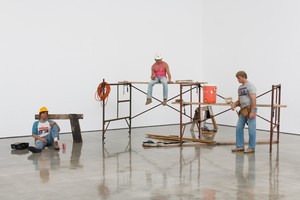
Benjamin Nugent reflects on questions of verisimilitude and American life in the group exhibition I Don’t Like Fiction, I Like History at Gagosian, Beverly Hills.

David Cronenberg’s film The Shrouds made its debut at the 77th edition of the Cannes Film Festival in France. Film writer Miriam Bale reports on the motifs and questions that make up this latest addition to the auteur’s singular body of work.
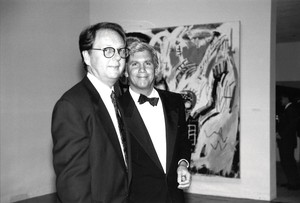
Alison McDonald celebrates the life of curator Richard Marshall.

Alice Godwin and Alison McDonald explore the history of Roy Lichtenstein’s mural of 1989, contextualizing the work among the artist’s other mural projects and reaching back to its inspiration: the Bauhaus Stairway painting of 1932 by the German artist Oskar Schlemmer.

The mind behind some of the most legendary pop stars of the 1980s and ’90s, including Grace Jones, Pet Shop Boys, Frankie Goes to Hollywood, Yes, and the Buggles, produced one of the music industry’s most unexpected and enjoyable recent memoirs: Trevor Horn: Adventures in Modern Recording. From ABC to ZTT. Young Kim reports on the elements that make the book, and Horn’s life, such a treasure to engage with.

Louise Gray on the life and work of Éliane Radigue, pioneering electronic musician, composer, and initiator of the monumental OCCAM series.

Tracing the history of white noise, from the 1970s to the present day, from the synthesized origins of Chicago house to the AI-powered software of the future.
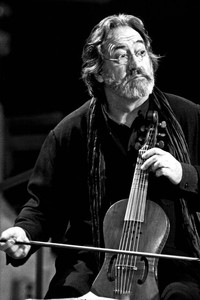
Ariana Reines caught a plane to Barcelona earlier this year to see A Sea of Music 1492–1880, a concert conducted by the Spanish viola da gambist Jordi Savall. Here, she meditates on the power of this musical pilgrimage and the humanity of Savall’s work in the dissemination of early music.
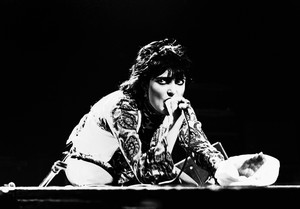
Dan Fox travels into the crypts of his mind, tracking his experiences with goth music in an attempt to understand the genre’s enduring cultural influence and resonance.
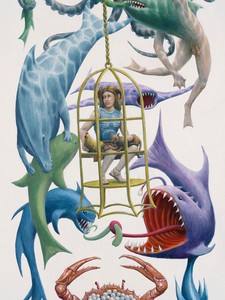
Charlie Fox takes a whirlwind trip through the Jim Shaw universe, traveling along the letters of the alphabet.
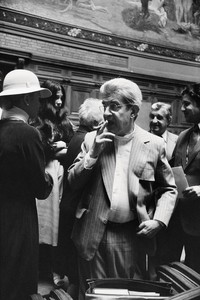
On the heels of finishing a new novel, Scaffolding, that revolves around a Lacanian analyst, Lauren Elkin traveled to Metz, France, to take in Lacan, the exhibition. When art meets psychoanalysis at the Centre Pompidou satellite in that city. Here she reckons with the scale and intellectual rigor of the exhibition, teasing out the connections between the art on view and the philosophy of Jacques Lacan.